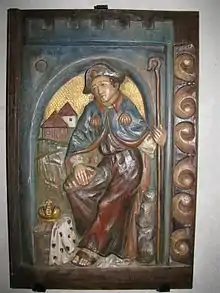Bertha of Bingen
Saint Bertha of Bingen (German: Heilige Berta, died ca. 757) was the mother of Rupert of Bingen. Her biography was written, and subsequently her cult popularized, by Hildegard of Bingen, who lived in the same region, about four hundred years later. Bertha and Rupert share a feast day on 15 May.
Saint Bertha of Bingen | |
|---|---|
 | |
| Born | unknown |
| Died | 757 |
| Venerated in | Roman Catholic Church, Eastern Orthodox Church |
| Feast | 15 May |
Overview
In 1150, Hildegard moved, with her nuns, from Disibodenberg to the Rupertsberg, a crag at the confluence of the Nahe and the Rhine, and established a monastery on the site of the ruined castle, where Bertha and Rupert were buried. The Vita Sancti Ruperti[1] was written about this time, "...to revive the cult of St. Rupert and to legitimize the vision that called her to move there".[2]
Bertha
Bertha was a Christian, descendant of the dukes of Lorraine, and had considerable property along the Rhine and Nahe Rivers. She married Robolaus, a pagan, who died soon after the birth of their son Rupert. Bertha devoted her energy to educating Rupert, but was struck by his precociousness in matters of Christianity. Inspired by his piety, she established several hospices for the poor. Following a pilgrimage to Rome to see the apostle's tombs, she gave away the rest of her possessions and came to live near Bingen (called Rupertsberg after her son). Rupert died at age 20, but Bertha outlived him by 25 years.[3]
Saint Rupert of Bingen | |
|---|---|
 | |
| Born | 712 |
| Died | 732 |
| Venerated in | Roman Catholic Church, Eastern Orthodox Church |
| Feast | 15 May |
Rupert of Bingen
Rupert of Bingen (German : Rupert von Bingen) (712–732) was the son of Bertha of Bingen, a Christian noblewoman. His father was a pagan called Robolaus (Robold). After his death, their child was raised as a Christian by his mother.
At the age of fifteen, Rupert undertook a pilgrimage to Rome with his mother, and is regarded as a patron saint of pilgrims. After his return, he used his inherited wealth to found churches, living with his mother on a hill at the Nahe River, near Bingen that came to be called the "Rupertsberg". Rupert died from a fever, aged 20.
During the Thirty Years' War, Rupert's relics were transferred to Eibingen, and his arm is still on display in a reliquary in Eibingen church.
References
- (included in Throop, trans., Three Lives and a Rule, Charlotte, VT: MedievalMS, 2010)
- King-Lenzmeier, Anne H., Hildegard of Bingen: An Integrated Vision, Liturgical Press, 2001, p. 122ISBN 9780814658420
- Hildegard of Bingen. Symphonia, (Barbara Newman, trans.)Cornell University Press, 1998, p. 294ISBN 9780801485473
Sources
- Herbert J. Thurston and Donald Attwater, eds. Butler's Lives of the Saints, vol. 2. Allen, TX: Christian Classics, 1956. Page 322.
- Anne H. King-Lenzmeier: Hildegard of Bingen: An Integrated Vision. Liturgical Press, Colledgeville 2001, ISBN 0-8146-5842-3, S. 122.